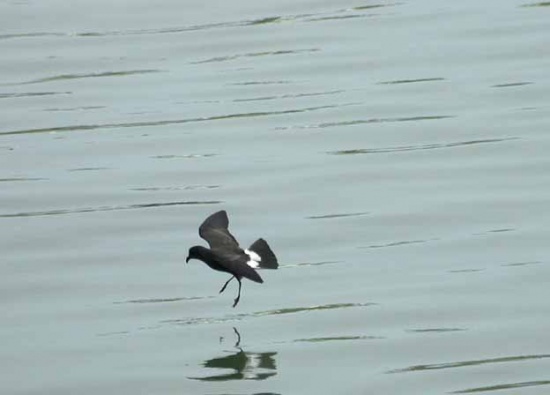m |
|||
| Line 1: | Line 1: | ||
| + | {{stub}} | ||
;Hydrobates pelagicus | ;Hydrobates pelagicus | ||
| − | [[Image:European_Storm_Petrel.jpg|thumb| | + | [[Image:European_Storm_Petrel.jpg|thumb|550px|right|Photo by creavey]] |
| + | |||
==Identification== | ==Identification== | ||
| − | + | ==Distribution== | |
| − | + | As a breeding bird this species is confined to the north-east Atlantic and Mediterranean with the bulk of the population in colonies on the west coasts of Britain and Ireland. There are smaller colonies to the north in southern Iceland; the Faroes and Lofoten Islands off Norway. Also breeds in the Channel Islands and off north-west and western France. In the Mediterranean there are colonies on the Balearics, and off southern Spain, Corsica and Sardinia, Sicily and Malta and there is a single colony in the Aegean. Breeding formerly occurred off Tunisia and has been reported from Canary Islands and Desertas but present status there is little-known. May also breed in Morocco. | |
| − | |||
| − | |||
| − | |||
| − | |||
| − | |||
| − | + | ==Taxonomy== | |
| + | ==Habitat== | ||
| + | Breeds colonially in burrows and rock crevices mainly on islands, sometimes on undisturbed mainland coasts. Nocturnal when visiting nest. Pelagic when not breeding and rarely seen from shore, only seen on land after being storm-driven. | ||
| + | ==Behaviour== | ||
==Bird Song== | ==Bird Song== | ||
<flashmp3>Hydrobates pelagicus (song).mp3</flashmp3><br /> | <flashmp3>Hydrobates pelagicus (song).mp3</flashmp3><br /> | ||
Revision as of 21:59, 23 July 2007
| This article is a stub. This article is short and lacking information. You can help the BirdForum Opus by expanding it. |
- Hydrobates pelagicus
Identification
Distribution
As a breeding bird this species is confined to the north-east Atlantic and Mediterranean with the bulk of the population in colonies on the west coasts of Britain and Ireland. There are smaller colonies to the north in southern Iceland; the Faroes and Lofoten Islands off Norway. Also breeds in the Channel Islands and off north-west and western France. In the Mediterranean there are colonies on the Balearics, and off southern Spain, Corsica and Sardinia, Sicily and Malta and there is a single colony in the Aegean. Breeding formerly occurred off Tunisia and has been reported from Canary Islands and Desertas but present status there is little-known. May also breed in Morocco.
Taxonomy
Habitat
Breeds colonially in burrows and rock crevices mainly on islands, sometimes on undisturbed mainland coasts. Nocturnal when visiting nest. Pelagic when not breeding and rarely seen from shore, only seen on land after being storm-driven.
Behaviour
Bird Song
<flashmp3>Hydrobates pelagicus (song).mp3</flashmp3>
Listen in an external program




